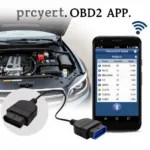When delving into the world of vehicle diagnostics, understanding the physical aspects of your OBD2 scanner and its connection point is as crucial as deciphering the codes it retrieves. This comprehensive guide dives deep into the world of OBD2 dimensions, answering your questions about size, compatibility, and more.
Demystifying OBD2 Dimensions
While the functionality of an OBD2 scanner is paramount, its physical size plays a crucial role in accessibility and ease of use. You might be wondering, “What are the standard OBD2 dimensions?” or “Will any OBD2 scanner fit my car?”. Let’s break it down:
Standard OBD2 Connector Dimensions
The OBD2 connector itself, often referred to as the DLC (Data Link Connector), adheres to a standardized design. This ensures compatibility across different vehicle makes and models.
- Shape and Pin Configuration: The OBD2 connector features a trapezoidal shape with a 16-pin configuration.
- Physical Size: While slight variations may exist between manufacturers, the general dimensions are approximately 1.8 inches (4.5 cm) in length and 0.6 inches (1.5 cm) in width.
This standardized design ensures that, theoretically, any OBD2 scanner should physically connect to your vehicle’s OBD2 port.
OBD2 Port Location and Accessibility
Locating your vehicle’s OBD2 port is the first step towards utilizing a scanner. In most vehicles manufactured after 1996, you’ll find the OBD2 port located within 2 feet (approximately 60 cm) of the steering wheel, often beneath the dashboard on the driver’s side.
However, variations can occur. Consulting your vehicle’s owner’s manual is always recommended for precise location. Accessibility can also vary, with some ports being easily accessible while others might require maneuvering around panels or wires.
OBD2 Scanner Size and Design Considerations
While the OBD2 connector itself is standardized, OBD2 scanners come in a variety of shapes and sizes.
- Compact Scanners: These pocket-sized devices prioritize portability and are ideal for individuals who require basic diagnostics on the go.
- Handheld Scanners: These offer a wider range of features and often incorporate larger screens for enhanced data display.
- Professional-Grade Scanners: These comprehensive tools are typically larger and come equipped with advanced functionalities for in-depth diagnostics and programming.
When choosing an OBD2 scanner, consider your specific needs and the accessibility of your vehicle’s OBD2 port.
Beyond the Basics: Additional Dimensional Considerations
While the standard OBD2 dimensions ensure a secure physical connection, certain scenarios might require additional adapters or extensions.
Adapters for Vehicle-Specific Connectors
Although the OBD2 standard aimed for universal compatibility, some vehicle manufacturers, particularly older models, might feature slightly different connector types. In these instances, a compatible adapter can bridge the gap, ensuring a secure connection between your OBD2 scanner and the vehicle’s diagnostic port.
Extensions for Enhanced Accessibility
In situations where the OBD2 port is situated in a particularly tight or awkward location, an extension cable can prove invaluable. These cables provide greater flexibility, allowing you to position the OBD2 scanner in a more convenient and accessible location for comfortable operation.
Wireless OBD2 Adapters: Eliminating Physical Constraints
For ultimate flexibility and convenience, consider a wireless OBD2 adapter. These devices plug into your vehicle’s OBD2 port and communicate wirelessly with your smartphone or tablet via Bluetooth or WiFi.
Wireless adapters eliminate the need for physical tethering, allowing you to perform diagnostics from anywhere inside your vehicle.
OBD2 Dimensions: Factors to Keep in Mind
- Compatibility: While the standardized OBD2 connector ensures a physical connection, always verify software compatibility between your chosen OBD2 scanner and your vehicle’s make, model, and year.
- Accessibility: Consider the location of your vehicle’s OBD2 port and choose a scanner or utilize extensions to ensure ease of access and comfortable operation.
- Functionality: The size and design of the OBD2 scanner should align with your diagnostic needs and preferences.
- Future-Proofing: Investing in a slightly larger or more feature-rich scanner might be beneficial if you anticipate future needs for advanced diagnostics or plan to use the scanner on multiple vehicles.
Conclusion
Understanding OBD2 dimensions goes beyond knowing the size of the connector. It’s about choosing the right tools and accessories to ensure seamless connectivity and optimize your diagnostic experience.
By considering the factors outlined in this guide, you can confidently navigate the world of OBD2 scanners and make informed decisions that align with your individual needs and vehicle requirements.
Frequently Asked Questions (FAQ)
1. What if my car doesn’t have a 16-pin OBD2 port?
Older vehicles might have different connector types. You’ll need a compatible adapter to connect your OBD2 scanner.
2. Can I leave my OBD2 scanner plugged in all the time?
It’s generally not recommended to leave it plugged in permanently. It’s best to disconnect it after use to avoid potential battery drain.
3. Are wireless OBD2 adapters as reliable as wired ones?
Yes, reputable wireless adapters provide reliable connections and data transfer.
4. Can I use an OBD2 scanner on any car?
While the connector might fit, software compatibility varies. Ensure your scanner supports your vehicle’s make and model.
5. What if my OBD2 port is damaged?
A damaged port requires professional attention. Contact a qualified mechanic for inspection and repair.
6. Can I use an extension cable with a wireless adapter?
Extensions are primarily for wired scanners to improve accessibility. Wireless adapters connect directly to the port.
7. Where can I find the exact dimensions of an OBD2 scanner before purchasing?
Product specifications, often found on the manufacturer’s website or retail listings, typically include dimensional information.
For further assistance or expert advice on OBD2 scanners and vehicle diagnostics, feel free to reach out to our dedicated support team via WhatsApp: +1(641)206-8880 or Email: [email protected]. We’re available 24/7 to help you find the perfect solution for your needs. You can also find more helpful information and articles on our website, including a comprehensive guide on obd2 connector mouser and a detailed explanation on how to panlong obd2 app change tire size.


